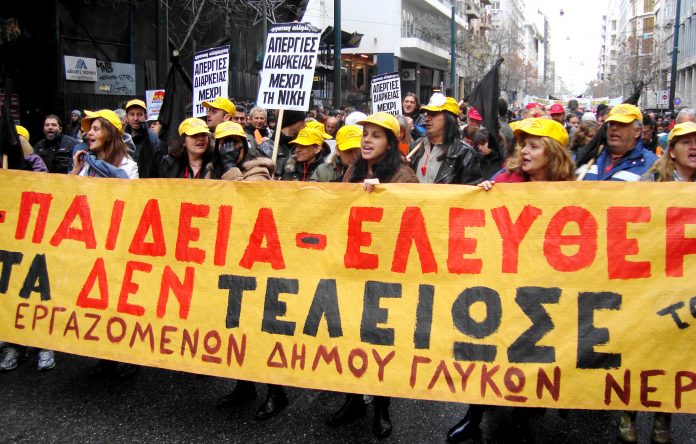
A HUGE march of over 100,000 workers and students held in Athens last Wednesday afternoon, as part of a 24-hour general strike, was viciously attacked by the Greek riot police who showered marchers with teargas canisters.
The one-day general strike was called by the GSEE (Greek TUC) against the new round of ‘austerity measures’ decided by the regime of Prime Minister Yiorghos Papandreou.
The strike proved to be a resounding success with solid 100 per cent participation of port workers, refinery workers, railway workers, urban transport workers, print workers and journalists.
All banks, department stores and shops remained shut in the Athens city centre.
Not a single ship or ferry sailed out of the Piraeus port. All railways, metro trains, buses and trams remained inside their depots.
No work at all was carried out on any building site. No newspapers were printed and there were no news or live programmes broadcast at all state and private television and radio stations.
Air controllers joined the strike too. The vast majority of schools were closed as a very high proportion of teachers joined the strike. In many schools in Athens schools students occupied their schools for Tuesday and Wednesday.
All universities were closed as well. Very high strike participation percentages were reported in state enterprises (electricity, telecommunications, post office), in local government and in the civil service.
Professionals such as lawyers and hospital doctors joined the strike. All courts remained shut as judiciary sector workers joined the action.
Strike rallies and demonstrations were staged in all Greek cities.
In Athens there were three different marches organised. The first to move off was the Greek Communist Party (KKE) march which attracted over 25,000 workers from the construction, engineering and clothing industries and a large section of students.
It was followed by the march of the Co-ordination of Trades Unions, of some 60-80,000 workers from all sectors and large contingents of university students and secondary school teachers.
Then the march of the GSEE leadership with about 15,000 workers participating from state enterprises and heavy industry.
Throughout the march’s route towards the Vouli (Greek parliament), dozens of armed riot police were placed in the side streets. About 200 riot police were placed on both sides of the students’ contingent in the Co-ordination of Trades Unions march.
As the marchers moved on, clashes broke out a few streets away between youths and riot police who made liberal use of teargas.
The KKE marchers reached the Vouli and quickly moved out and dispersed. Then the head of the Co-ordination of Trades Unions march entered the large square in front of the Vouli.
The march passed by some luxury hotels and youths attacked vehicles parked outside which were set on fire.
Riot police launched a sustained attack on the march with dozens of noise-smoke and lightning bombs, made in the Czech Republic, and teargas canisters made in the US.
The demonstration was cut in half. Havoc broke out in the square with full scale fighting between riot police and workers.
Marchers retreated as they could not stand the teargas which affects breathing and eyes.
A cloud of teargas filled the square. Then the so-called Delta Force of the riot police on motorcycles also attacked.
But workers and students stood their ground. They re-grouped and marched again past the Vouli building towards the University of Athens through a hail of canisters thrown at them by riot police.
Fighting continued throughout the Athens city centre and some barricades were put up by students who also set fire to rubbish bins to diminish the effect of the teargas.
Angry workers attacked the right wing parliamentary deputy and ex cabinet minister Kostis Chatzidakis as he was walking to the Vouli. Police announced that some 20 arrests were made and 17 police injured.
When the fighting broke out in the Vouli square, the GSEE-led march was still about a mile away.
Once the GSEE bureaucrats heard about the riot police attacks they ordered workers to disperse and go home!
But several trade unions, including the transport unions, refused to obey and marched on towards the Vouli.
The desertion of the GSEE leaders infuriated workers who decided to march to the GSEE’s HQ; but riot police once again attacked them with teargas.
Workers were blaming the GSEE leaders for not calling a general strike for Tuesday, the day the government voted the ‘Emergency Measures for the Economy’ Bill.
The size and militancy of Wednesday’s general strike march can only be compared with the magnificent demonstrations against the IMF last spring.
But this time the slogans shouted by marchers were qualitatively different as the calls for the overthrow of the ‘Papandreou junta of the IMF-EU’, for ‘continuous struggle’ and for ‘indefinite strike’ dominated the march.
Wednesday’s general strike and massive march marked a most important political development in the Greek working class and students as anger is being transformed into revolutionary practice and consciousness.
Thus the utterly urgent task now is the building of a mass revolutionary party to lead the working class to the overthrow of capitalism and to the establishment of a workers’ and small farmers’ government.
Late on Wednesday night the Co-ordination of Trade Unions issued a call for a mass picket of the GSEE HQ on Thursday, and a demonstration the day after.
It also appealed to the major trade unions and trade union federations for another general strike next Wednesday – the day the government’s Budget will be presented at the Vouli.